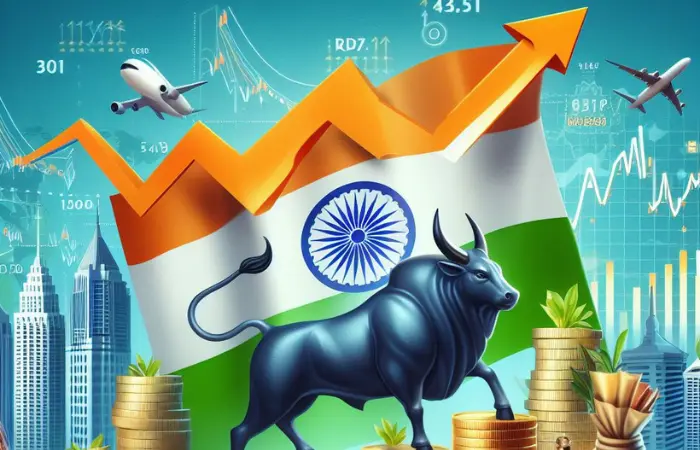In a recent analysis, global brokerage firm Jefferies has painted a promising picture for India’s economic future. According to their projections, India is poised to claim the title of the third-largest economy globally by the year 2027. This prediction is grounded in a combination of factors, including a consistent growth rate in the Gross Domestic Product (GDP), favorable geopolitical conditions, and an ongoing commitment to reforms.
Over the last decade, India has seen remarkable economic growth, with its GDP experiencing a Compound Annual Growth Rate (CAGR) of 7% in USD terms, reaching $3.6 trillion. This ascent has propelled India from the 8th to the 5th position among the world’s largest economies. Looking ahead, Jefferies anticipates India’s GDP to reach $5 trillion within the next four years, solidifying its position as the third-largest economy, surpassing both Japan and Germany. Several factors contribute to this optimistic outlook. India benefits from a demographic dividend, with a consistent labor supply serving as a driving force for economic growth. Additionally, improvements in institutional strength and governance further bolster the nation’s economic trajectory.
Jefferies underlines that India’s economic momentum is becoming too significant for major global investors to overlook. Despite currently ranking as the world’s 5th largest market by capitalization, with $4.5 trillion, India’s representation in global indices is relatively modest, standing at 1.6% and holding the 10th position. The brokerage firm suggests that as India’s market free float increases and certain anomalies in weightings are addressed, the country’s significance in global indices will rise, according to Jefferies’ note, if market returns align with the trends of the past two decades and new listings emerge, India could potentially reach an impressive market capitalization of nearly $10 trillion. This prediction indicates a significant economic leap for India, marking it as the fastest-growing large economy on the global stage. The dynamics of demographics, institutional strengthening, and improved governance are expected to propel India into a prominent position in the world economy.
Also Read- “How Indian Startups are Driving India’s $5 Trillion Economy Ambition”
Factors To Boost Indian Economy:
Supportive Global Geopolitics: A Shift in Investment Trends:
The last decade has witnessed a remarkable reversal in the investment landscape in India. What was once a period marked by a 10-year investment downcycle and risk aversion has now transformed into a thriving environment for entrepreneurship. Contributing to this shift is the current housing upcycle and a corporate debt-to-equity ratio at an all-time low. India has emerged as a global unicorn hub, boasting 111 unicorns with a collective market value of $350 billion, placing it third globally after the US and China. The government’s strategic focus on developing digital infrastructure, combined with globally competitive data rates and a rich pool of homegrown talent, has played a pivotal role in driving this positive trend.
India as a Services Exports Hub: A Growing Economic Pillar:
India’s economic landscape has evolved, with services exports now accounting for nearly $450 billion annually. The country has become a hub for services, with numerous global organizations choosing to base 10-20 percent of their workforce in India, including prominent names like JP Morgan, Intel, and NTT. The combination of superior digital infrastructure and a young, well-educated workforce positions India to continue the upward trajectory of services exports.
Nurturing a Strong Corporate Culture: A Boon for Investors:
One of the key strengths of India’s economic fabric lies in its Return on Equity (RoE)-focused corporate sector, presenting a positive outlook for minority investors. The listed equity market stands out among the most diversified emerging markets. The robust institutional framework, led by regulators such as SEBI and RBI, along with responsible asset managers, has played a crucial role in cultivating a large domestic investor base. This has resulted in a sustainable investment pattern, with an anticipated flow of $50 billion per year into equities from domestic investors. While this is likely to maintain valuations on the higher side, it also contributes to a reduction in market volatility.
Some Frequently Asked Questions:
What is Jefferies’ prediction for India’s economic status by 2027?
Jefferies forecasts that India will secure the position of the third-largest global economy by 2027. This optimistic outlook is based on factors such as consistent GDP growth, supportive geopolitics, and ongoing economic reforms.
How has India’s GDP growth evolved over the past decade?
Over the last 10 years, India’s GDP has experienced a Compound Annual Growth Rate (CAGR) of 7% in USD terms, reaching $3.6 trillion. This substantial growth has propelled India from the 8th to the 5th position among the world’s largest economies.
What factors contribute to India’s economic ascent, according to Jefferies?
Jefferies attributes India’s economic momentum to a combination of demographic advantages, consistent labor supply, improved institutional strength, and governance reforms. These factors collectively position India as the fastest-growing large economy globally.
Why does Jefferies consider India’s trajectory “impossible for large global investors to ignore”?
Despite currently ranking as the world’s 5th largest market by capitalization, India’s representation in global indices is modest at 1.6%. Jefferies suggests that as India’s market free float increases and weight anomalies are addressed, global investors will find India’s economic trajectory increasingly compelling.








[…] Also Read- India’s Ascension: Jefferies Predicts Third-Largest Economy Status by 2027 […]